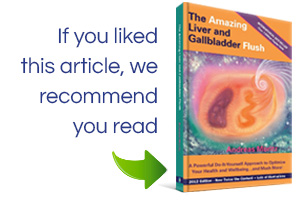By: Andreas Moritz
Posted: December 8, 2011 — updated 2016
Book excerpt: The Amazing Liver and Gallbladder Flush
During the morning and, perhaps, afternoon hours following the liver flush, you will have a number of watery bowel movements. These initially consist of gallstones mixed with food residue, and then just stones mixed with water. Most of the gallstones are pea-green and float in the toilet because they contain bile compounds. The stones will be in different shades of green and may be bright-colored and shiny like gemstones. Only bile from the liver can cause this green color.
Gallstones can come in many sizes, colors and shapes. The light colored stones are the newest. Dark-green stones are the oldest. Some are pea-sized or smaller, and others are as big as 1 inch in diameter. There may be dozens and, sometimes, even hundreds of stones (of different sizes and colors) coming out at once. Also, watch for tan-colored and white stones. Some of the larger tan or white stones may sink to the bottom with the stool. These are calcified gallstones that have been released from the gallbladder. They contain heavier toxic substances, with only small amounts of cholesterol. All the green and yellowish stones are as soft as putty, thanks to the action of the apple juice.
You may also find a layer of white or tan-colored chaff, or ‘foam’, floating in the toilet. The foam consists of millions of tiny white, sharp-edged cholesterol crystals, which can easily rupture small bile ducts. They are equally important to release.
Try to make a rough estimate of how many stones you have eliminated. To permanently cure bursitis, back pain, allergies, or other health problems, and to prevent diseases from arising, you need to remove all the stones. This may require at least 8 to 12 flushes, which can be performed at three-week or monthly intervals. (Do not flush more frequently than that!)
The three-week break between flushes may include the six-day preparation for the next liver flush. But most ideally, it should start after the three weeks have passed. If you cannot flush this often, you may take more time between flushes. The important thing to remember is that once you have started cleansing the liver, you should keep cleansing it until no more stones come out during two consecutive flushes. Leaving the liver half clean for a long period of time (three or more months) may cause greater discomfort than not cleansing it at all. The liver, as a whole, will begin to function more efficiently soon after the first flush, and you may notice sudden improvements, sometimes within several hours. Pains will lessen, energy will increase, and clarity of mind will improve considerably. However, within a few days, stones from the rear of the liver will have traveled ‘forward’ toward the two main bile ducts (hepatic ducts) in the liver, which may cause some or all of the previous symptoms of discomfort to return. In fact, you might feel disappointed because the recovery seems so short-lived. Yet all of this merely indicates that some stones were left behind, ready to be removed with the next round of cleansing.
Nevertheless, the liver’s self-repair and cleansing responses will have increased significantly, adding a great deal of effectiveness to this extremely important organ of the body. As long as there are still a few small stones traveling from some of the thousands of small bile ducts to any of the hundreds of larger bile ducts, they may combine to form larger stones and produce previously experienced symptoms, such as backache, headache, ear ache, digestive trouble, bloating, irritability, anger, and so forth, although these may be less severe than they were before.
If two consecutive new cleanses no longer produce any stones, which may happen after 6 to 8 flushes (in severe cases it may take 10 to 12 or more), your liver can be considered ‘stone-free’. Nevertheless, it is recommended that you repeat the liver flush every six to eight months. Each flush will give a further boost to the liver and take care of any toxins or new stones that may have accumulated in the meantime.
Caution: Never cleanse when you are suffering an acute illness, even if it is just a simple cold. If you suffer from a chronic illness, however, cleansing your liver may be the best thing you can do for yourself.
This is an excerpt from Andreas Moritz‘s book The Amazing Liver and Gallbladder Flush.
You may share or republish this article provided you clearly mention the name of Andreas Moritz and paste a hyper link back to the post: https://www.ener-chi.com/the-results-you-can-expect-from-the-amazing-liver-flush/

